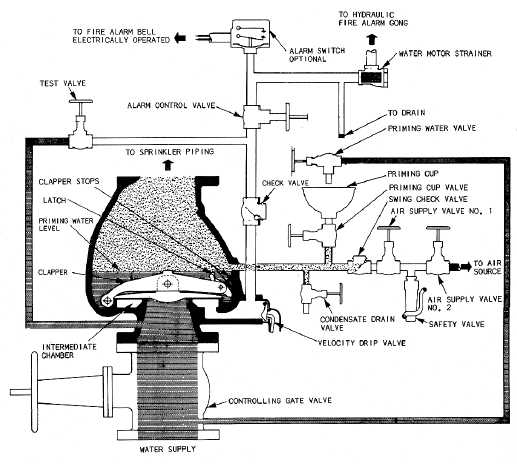DIFFERENTIAL DRY PIPE VALVE. - The differential dry pipe valve (fig. 8-3) has a large clapper on the air side that bears directly on a smaller water side clapper. The differential between the areas of the two clappers is approximately 6 to 1. Therefore, relatively low air pressure can hold back a much larger water pressure. For example, 30 pounds per square inch (psi) air pressure can hold back 180 psi water pressure.
To eliminate an accidental trip of the valve and false alarms, air pressure should be maintained at least 20 psi greater than the calculated trip pressure of the dry pipe valve. This is based on the highest normal water pressure of the supply system.
In operation, when there is a fire the heat actuates the sprinklers and allows the air pressure to be relieved from the piping network. The differential is destroyed. The water pressure below the valve opens the clapper, allowing water to flow through the piping to the open sprinklers. This operation has an inherent time delay between the actuation of the sprinklers and the application of water to the fire. This delay can be shortened by adding an accelerator or an exhauster to the dry pipe system.
The accelerator (fig. 8-4) allows air from the system's piping to enter the intermediate chamber in the dry pipe valve, destroy the differential, and open the clapper.
The exhauster (fig. 8-5) opens and exhausts air from the piping system faster than through the sprinklers, destroying the differential sooner.
LOW-DIFFERENTIAL DRY PIPE VALVE. - Occasionally the water supply to dry pipe valves contains debris. With a differential dry pipe valve, the high velocity of water entering the system when the valve trips can carry the debris into the system, plugging system piping and sprinklers. If debris in the water is a problem, the low-differential dry pipe valve (fig. 8-6) may be useful.

Figure 8-3. - Differential dry pipe valve.
Continue Reading